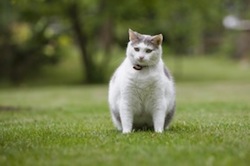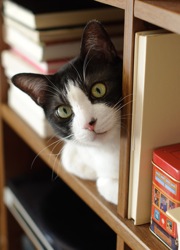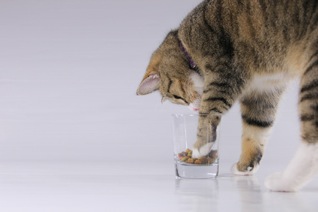How to handle overweight cats ?
 Cats have less energy requirements than dogs, What predisposes them to obesity (a cat needs two times less important than those of a dog of the same size). To quickly combat any excess weight, not because of the physical appearance that gives to the cat, but more for maintain the animal in excellent health.
Cats have less energy requirements than dogs, What predisposes them to obesity (a cat needs two times less important than those of a dog of the same size). To quickly combat any excess weight, not because of the physical appearance that gives to the cat, but more for maintain the animal in excellent health.
Indeed, Obesity promotes the appearance of pathologies (it may for example generate Diabetes) and it aggravates all pre-existing conditions.
A significant excess weight thus decreases so significantly the quality of life of the cat and his life expectancy.
When do I feel that my cat is overweight ?
Given the individual variations in size and pattern in cats, it is not possible to define an "ideal" weight for a cat of a particular age.
A simple method, on the other hand, estimate if your pet is too big or not:
A cat has a healthy weight if possible, by placing hands flat on each side of his chest, easily count his ribs with the fingertips, without support.
If the ribs are difficult to count, the animal is overweight.
Furthermore, fat preferentially accumulates in the groin area in cats. If a pocket of fat is present in the lower abdomen kitty, he is too fat.
Why my cat is it too big?
Being overweight has many possible origins: It can be problems regarding the cat's lifestyle or environment in which it operates. Dietary errors can also cause weight gain. Finally, some diseases are often accompanied by obesity.
Overweight linked to the living environment of the cat or changes in lifestyle
STERILIZATION
Spaying reduces 30% the energy needs of the cat and tends to increase its food intake and to make it more sedentary: he eats more and exercises less…
Your veterinarian will advise you adequate food the changes brought by the intervention to prevent weight gain.
LIVING ENVIRONMENT SOME EXCITING
When the cat's living environment is too quiet, no distraction is offered to him (present few games at home, no possibility of release…), or that there is only permanently, he will develop some form of anxiety which can itself lead to the onset of bulimia : the cat is a calm in food consumption.
This "boredom" is sometimes highlighted by abnormal animal behavior as a little "crazy quarter hour" evening, attacks around mealtimes, or the "attacks" on all things moving (including owners…)
CHANGING ENVIRONMENT
Sometimes, the cat has lived in an environment that suited him perfectly but an important change will change their habits and be accompanied by weight gain. This may be the case when:
~ Move a house with a garden for an apartment
~ Death of a family member or an animal with which the cat was playing tremendously
~ Disaster Recovery owners after a work stoppage or long period of absence of teachers for holidays…(the cat is then left alone all day)
Errors on the type of food offered or its mode of distribution
DISTRIBUTION MODE
Many food mistakes committed by ignorance of eating the cat in the wild:
In nature, it drives many prey all day. So eat small amounts but 15 to 20 times a day.
Often, the cat gets two big meals in the day. He then has no access to food at all times as he wants, which the stress.
As soon as we offered him a meal, he eats very quickly by "fear of missing" and the owner, with the impression that the cat has not eaten "his fill", it offers a new ration: a vicious circle appears…
FEED INCORRECT
poor quality of food or inadequate can also cause weight gain.
Too rich food fat increases the palatability of the diet: then the cat eats more than his fill.
obesity diseases responsible
Some cases of obesity can be explained by disease or previous treatment of the cat that can cause significant weight gain. This is the case when endocrine disorders (diabetes or thyroid problems), malformations or tumors of the central nervous system or repeated administration of certain drugs such as corticosteroids.
behavioral disorders
Two types of behavioral pathologies may explain in cats the absence of regulation of food intake: one hyperactivity or a serious issue ofanxiety or one depressed state.
HYPERACTIVE CHAT
Some cats with overactive fail to control himself: they are permanently active and never manage to calm down. They feel, Furthermore, phave the feeling of satiation and eat very large amounts of food.
Eating disorders are accompanied, in this case, other behavioral problems: these cats are particularly brutal when they play and very clumsy (they overturn all before them…), they are constantly in motion and very little sleep.
Excess weight of these animals is often limited due to their ongoing activity and frequent vomiting after absorbing too fast meals.
DEPRESSION OR ANXIETY DISORDERS
When an animal is very anxious, he can find some relief in the eating.
Obesity can be directly related to the presence of severe anxiety or depression.
Other behavioral abnormalities can then be identified and confirm the discomfort cat:
~ Sleep Disorders (brutal awakenings, reversal day / night)
~ Toilet absent or conversely too important (the cat is up
tear all the hair under the belly to force lick…)
~ Malpropreté
~ Chat "lost", confused, that constantly meowing
~ Abnormally fearful Chat
~ Chat still down, which have no interest in games…
How to lose weight my cat ?
Overweight linked to the cat's lifestyle or dietary errors
When the excess weight of the animal is directly associated with the type of food, how it is distributed, or in an environment too "boring", unfavorable movements and energy costs, some simple changes generally allow a clear improvement of the situation.
Your veterinarian will help you develop a real "weight loss plan," taking into account the food preferences of your pet and which will chat minimal exercise.
INSERTING AND VARIOUS OTHER GAMES IN HOUSING
 To ensure the cat a minimum of physical exercise, it will be offered various games of observation, of hunting, prosecution-races, fun activities to share with his teachers and, if possible, outputs (to the streets leash, a small balcony or in the garden)
To ensure the cat a minimum of physical exercise, it will be offered various games of observation, of hunting, prosecution-races, fun activities to share with his teachers and, if possible, outputs (to the streets leash, a small balcony or in the garden)
All these activities will, not only, ofincreasing physical activity Of the cat (thus limiting weight gain) but also toimprove mood (with decreased risk of overeating by anxiety).
CORRECTING ERRORS FOOD
The ideal way of food distribution is the one that is closest to the cat's feeding mode in nature:
The cat should have access to small amounts of food throughout the day.
The chosen food will not be too palatable (for the cat eats without excess) and the amount of food to be distributed will be carefully calculated by your vet based on the ideal target weight to ensure a gradual weight loss while avoiding any risk of deficiency.
Food preferences of your pet will be considered. Thus, several types of plans may be offered him:
– a diet based on a household ration (vegetables, meat, starches and vitamins containing dietary supplement and trace elements) in amounts carefully calculated
– an industrial-based dry food diet (Diet kibble)
– a mixed industrial ration (including both kibble and cans or bags for cat chills suitable for weight loss)
To respect the cat's natural feeding, rations will be distributed throughout the day. virtually, if the cat is accustomed to wet food, small quantities of boxes or bags chills will be distributed to him many times during the day, while allowing it access to self-service croquettes.
For increase the food intake time, various games will be set up around the power supply: fixing of a plastic cup height forcing the cat to recover croquettes with paw, ball or cylindrical distributor holes that drop kibble when the cat puts in motion, nuggets hidden in various locations in the home inaccessible (under carpets, in narrow passages…).Leave room for your imagination! Thanks to these games that increase food intake time, the cat will feel like eating much while the same amount of food will be given to him.
Changes in diet should be smooth to allow the cat to gradually adapt it without stress.
It is very important to ensure that the cat accepts his regime and he never stays more 48 hours without eating. Indeed, weight loss too fast and far too limited quantities ingested can cause in cats with severe liver problems (hence the importance of considering food preferences of the animal and carefully calculate rations to provide it with your veterinarian)
Do not hesitate to inform your veterinarian of any problems encountered during the regime (cat refuses to eat, appearance of assaults mewings insistent or around food…). It will help you make changes to the plan to reduce the feeling of hunger cat by increasing the volume of the ration distributed or improving its palatability (for example, by replacing part kibble by a moist food or very low calorie vegetables such as courgette)
Overweight associated with a disease or a chronic behavioral disorder
When excess weight of the animal is associated with an illness or behavioral problems that gave rise to severe anxiety or even depression, one medical care becomes indispensable.
DISEASES LIABLE FOR OBESITY
When a precise pathology explains the animal's weight gain (endocrine disorders such as diabetes, central nerve damage…), only e specific treatmentt this disease will allow the cat to regain a normal weight.
HYPERACTIVITY, ANXIETY AND DEPRESSION
When obesity is indicative of severe behavioral disorders such as hyperactivity, high anxiety or depression, your veterinarian will not only establish a behavioral therapy for your cat, but it will be associated with a medication that will help the cat to find a "wellness".
§
Overweight cats may have various origins. In some cases, the establishment of medical treatment will be necessary to return to a healthy weight. In other, a diet suffira. However, this plan must be implemented gradually, be well studied and reflect the tastes of the animal to avoid failure. Do not hesitate to seek advice from your veterinarian.
This article is protected by copyright © Vetup

